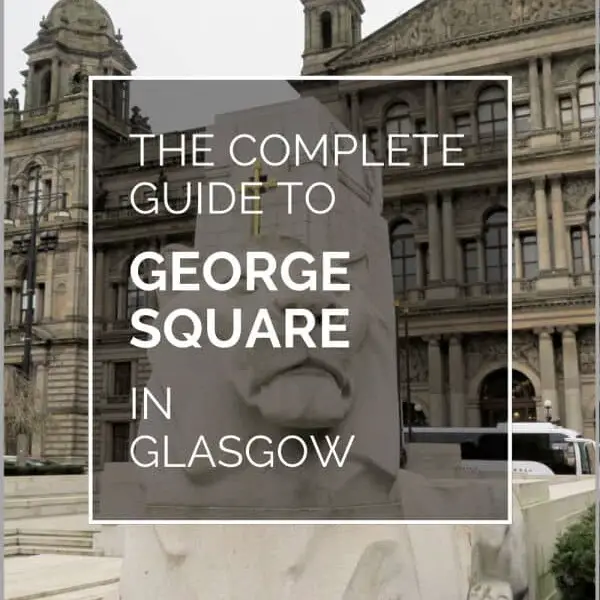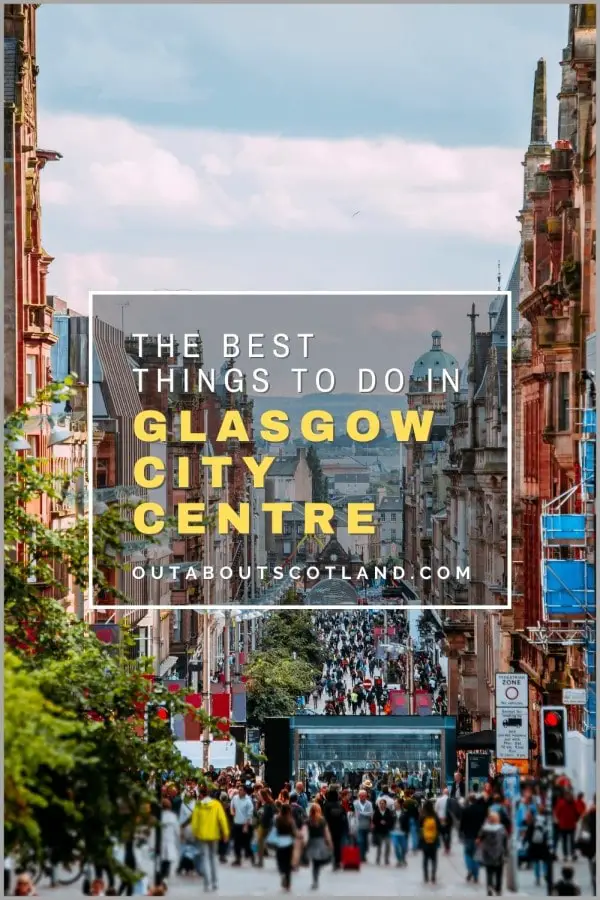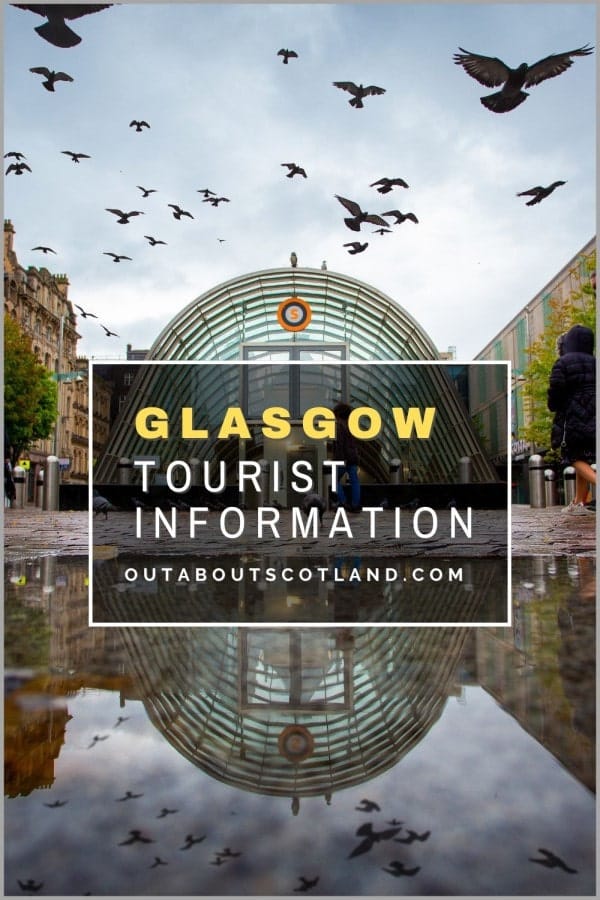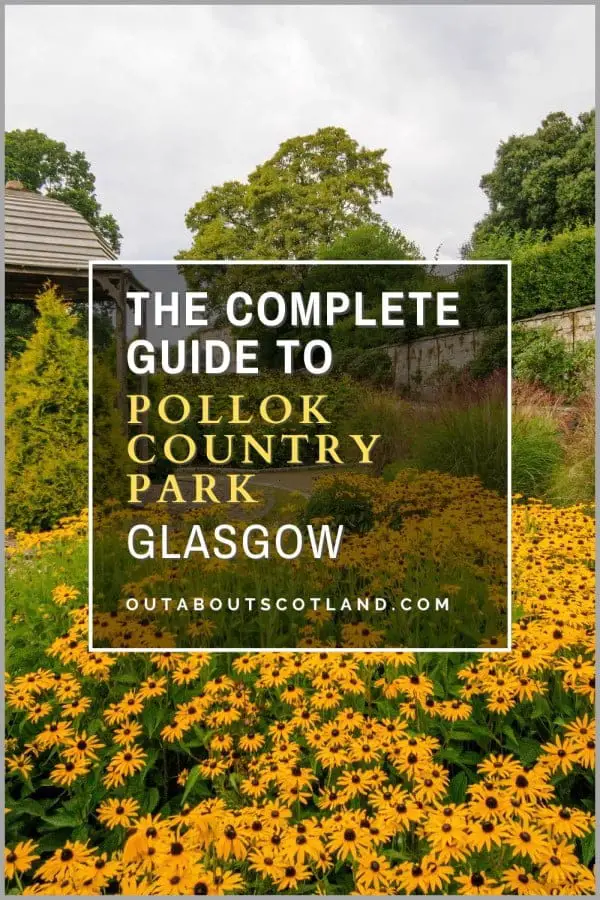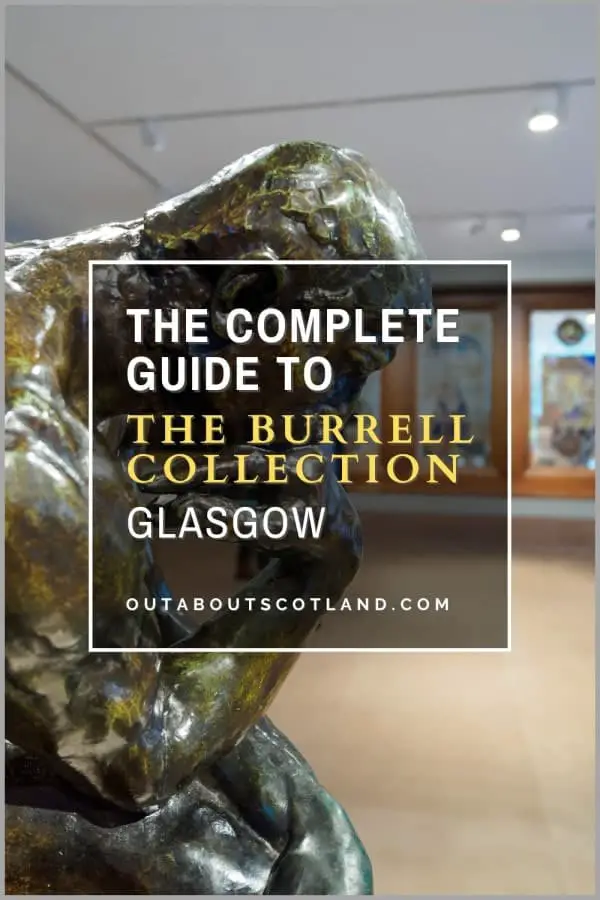George Square is the main civic centre in Glasgow. The square hosts several major events throughout the year and is home to many historical monuments. Glasgow’s main war memorial is located at one end of the square in front of the Glasgow City Council Chamber, and attractions including the Gallery of Modern Art are within a short walking distance.
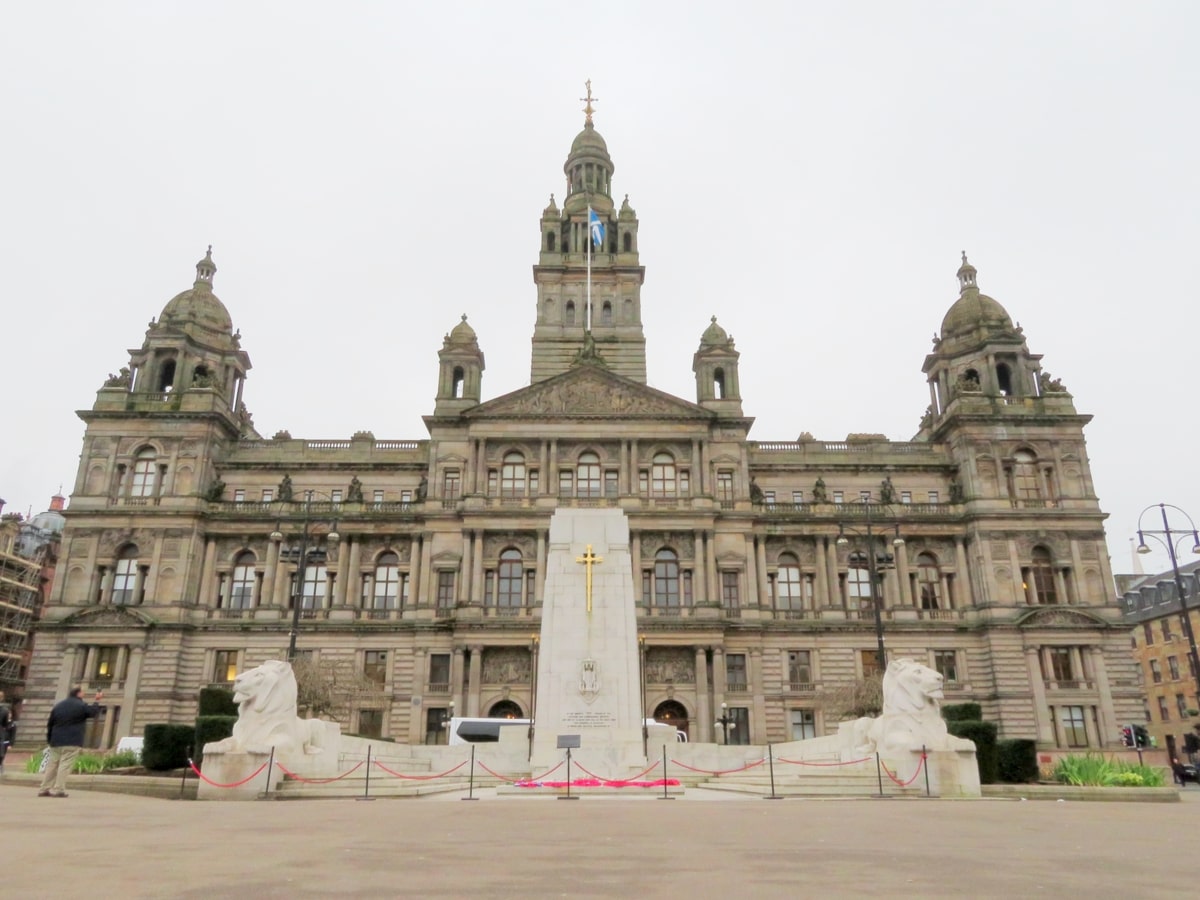
Overview
If you ever visit Glasgow by train, the end of your line will more than likely be Queen Street station in the centre of the city. From there, most people will either catch a bus to one of Glasgow’s many tourist attractions or walk around the square on their way to the shops, totally bypassing one of the most important historic sites in the city.
George Square offers much more than a quick selfie in front of its statues, and if you stop to appreciate what’s on display you’ll find it’s home to one of the best collections of listed buildings and monuments in Scotland.
The main focal point of the square is the towering Scott Monument in the centre that’s dedicated to Scotland’s greatest wordsmith Sir Walter Scott, while the gleaming white Cenotaph and equally impressive City Chambers lie to the east. On the western side, you’ll find statues of Queen Victoria and Prince Albert on horseback with the perimeter of the square playing host to a collection of statues of noteable Scots.
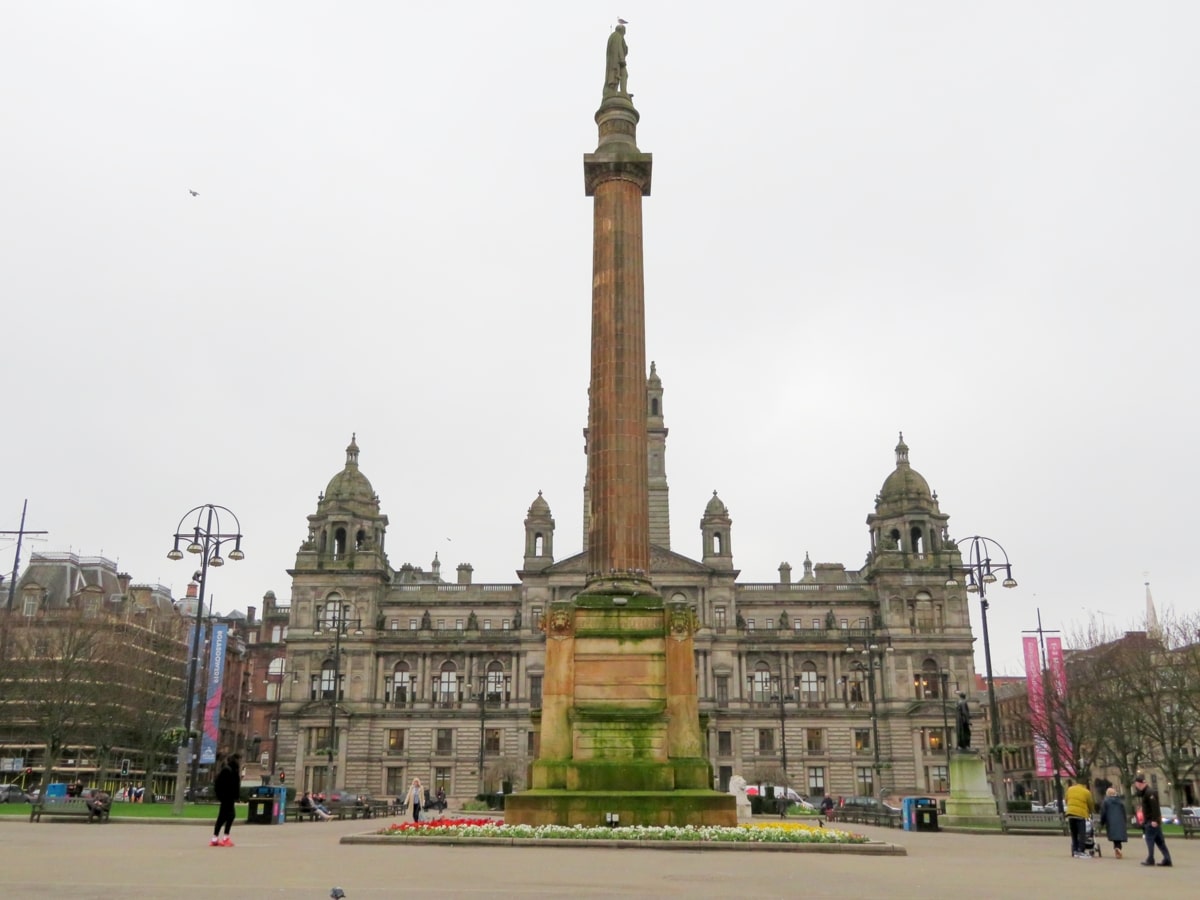
But there’s more to this historic site than monuments and old buildings. As the beating heart of the city, George Square is the venue for a variety of events, and depending on what time of year you visit, you might be lucky enough to attend two of the biggest festivals in the city’s calendar: Glasgow Loves Christmas and Piping Live!
The Christmas event is fantastic and 100% recommended thanks to the mixture of Christmas markets, street food stalls, and themed rides, while the Piping Live! event held annually in August is one of the venues of the World Pipe Band Championships.
Perhaps the best thing about George Square is that it’s located in the middle of the city’s renowned shops, bars, and restaurants, so it’s easy to find something to do after you’ve taken in the highlights.
The Gallery of Modern Art can be found just around the corner on Queen Street, less than a 5-minute walk away, while Glasgow Cathedral is less than 20 minutes away on foot. Both attractions are free to enter and worth visiting after you’ve explored George Square.
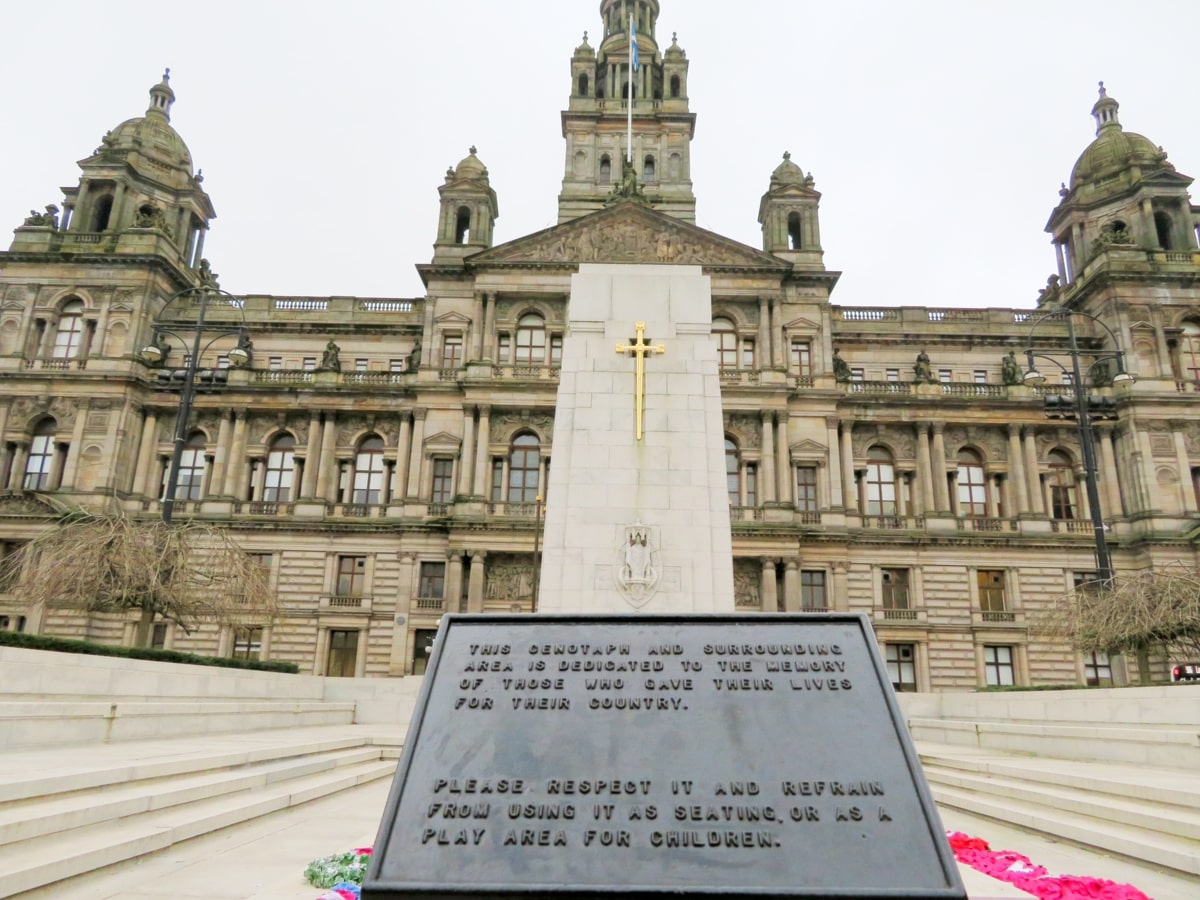
The Highlights
1: Admittedly, this isn’t exactly the number one attraction in Glasgow, but there’s a lot of history in George Square and it’s a good place to start a tour of the city.
2: George Square is also a great event venue. The highlight has to be Christmas and the Glasgow Loves Christmas Festival. In addition, there are smaller events held throughout the year.
3: If nothing else, the central location of George Square means it’s close to the train station, so visitors can have a quick look around the monuments before crossing the road to Queen Street station.
Visiting Tips
1: Download the George Square Heritage Trail to your phone so you can read about the monuments as you walk around them.
2: Combine your visit to George Square with the nearby Glasgow Gallery of Modern Art or explore the city centre by following the Glasgow Mural Trail.
3: It’s only around a 15-minute walk from the city centre to Glasgow Cathedral, so George Square makes a nice stopping-off point.
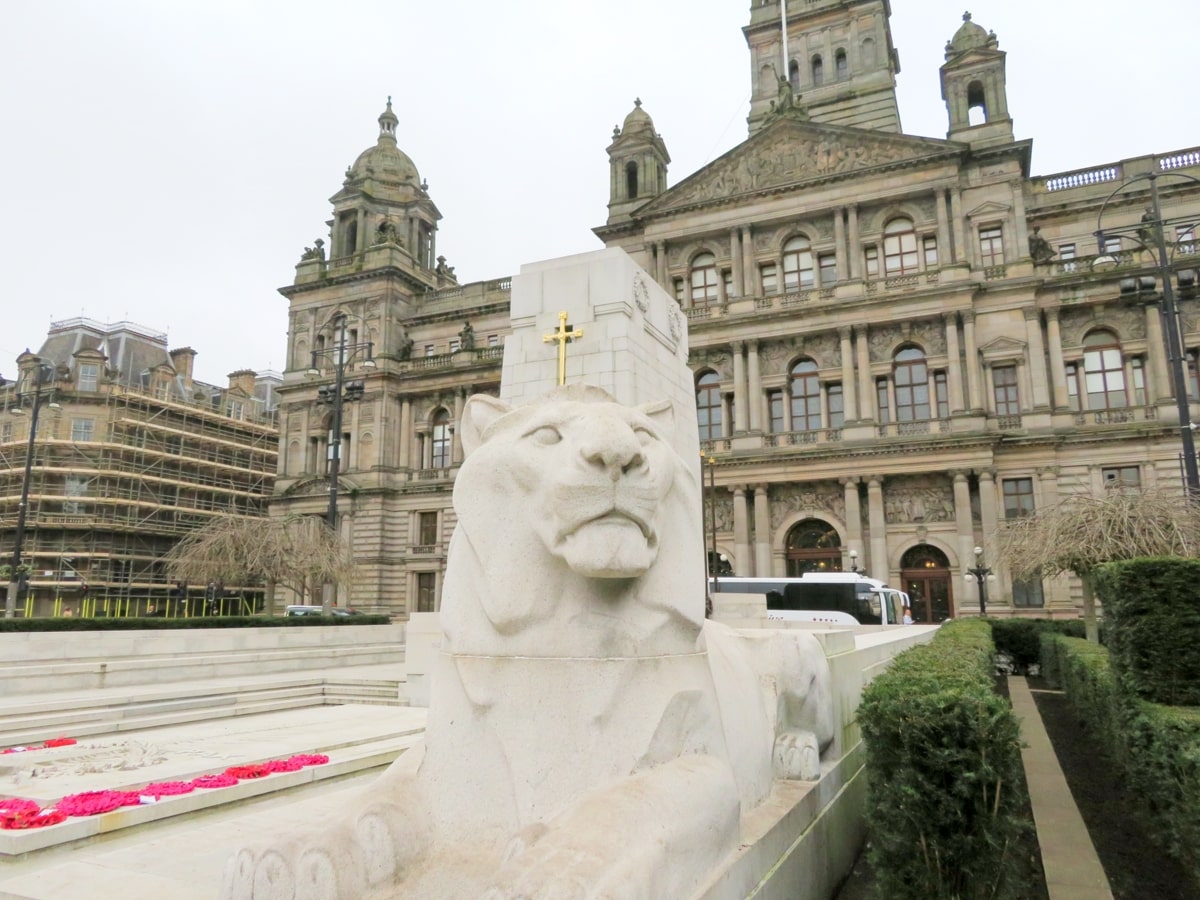
Tourist Information
At first glance, you could be forgiven for thinking it won’t take you long to walk around this square (and, in all honesty, if you’re not interested in history, it won’t), but stop and look at each monument and you’ll be surprised by what you find.
The square is surrounded on all sides by some of the finest examples of Victorian architecture in Scotland, but it’s the enormous City Chambers that first catches your eye as it totally dominates the space. This enormous building was designed in the Italian Renaissance style and has to be one of the most extravagant buildings in Glasgow.
Take a look inside and you’ll see it’s full of ornate plasterwork and mahogany fittings that might remind you of Holyrood Palace in Edinburgh. Because it’s an active workplace, it isn’t open to the public at all times, but they do open it for viewing twice daily.
The first time I visited, I just poked my head inside before strolling back out, thinking I’d get in trouble – it’s a working civic building after all – but I eventually noticed that you can join 45-minute tours around the building at 10.30 am and 2.30 pm Monday to Friday, at no cost.
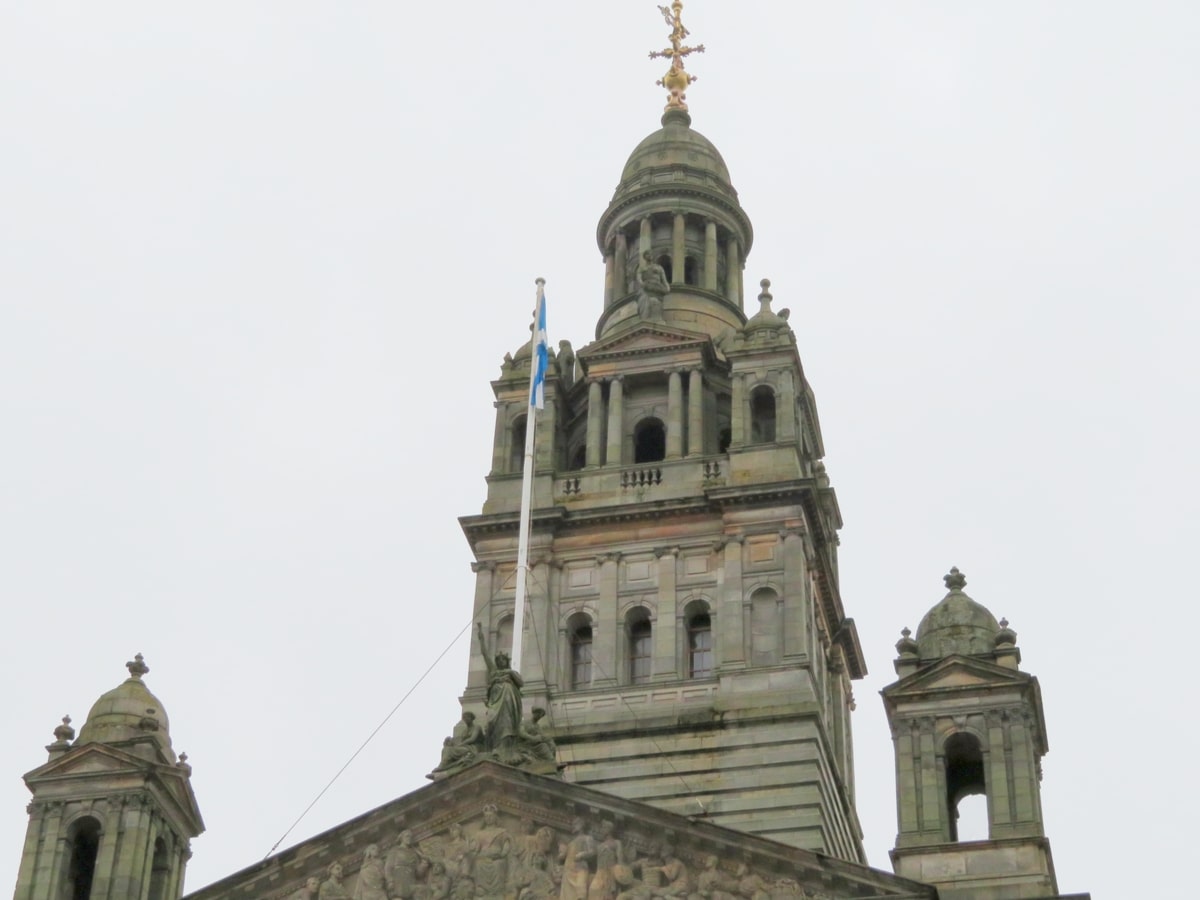
My advice is to get your ticket early as they only allow 25 people per tour but all you have to do is ask for a ticket from the reception desk 30 minutes beforehand (unfortunately they don’t let you pre-book them).
Heading back to the square, you’ll find yourself facing the Cenotaph which is Glasgow’s monument to the soldiers who died in the First World War. The centre of this imposing granite monument is a truncated obelisk around 10 metres tall, flanked by two lion sculptures that have been keeping guard since being unveiled by Earl Haig in 1924.
Turn 180 degrees from the Cenotaph and you’ll see the statue dedicated to one of Scotland’s greatest writers, Sir Walter Scott. Scott’s statue stands on top of an 80-foot column in the centre of George Square that’s nowhere near as big as Edinburgh’s Scott Monument (which you can read about in The Scott Monument) but is just as historically significant, having been erected a full decade before the one in Prince’s Street was unveiled.

If you look around the perimeter of the square you’ll see several other statues of Scotland’s great and good, including the two biggest on its western edge which represent Queen Victoria and Prince Albert riding on horseback.
The other statues are dedicated to influential Scotts who left their mark in the arts, science, and military, and if you follow the heritage trail you’ll be able to read the plaques under each statue to find out who they are.
I’ll list the statues below in order from the north-west of the square, moving clockwise:
- Robert Peel – 1788-1850. A political figure who reformed British criminal law.
- William Gladstone – 1809-1898. A political figure who served as Prime Minister four times.
- James Oswald – 1779-1853. A politician who was a leading supporter of the Reform Act of 1832.
- Thomas Graham – 1805-1869. Pioneer in the field of chemistry.
- Thomas Campbell – 1777-1844. Scottish poet, historian and political commentator.
- Field Marshall Lord Clyde – 1792-1863. Military commander famed for his win at the Battle of Balaclava in 1854.
- Sir John Moore – 1761-1809. British army officer who was regarded as the greatest trainer of infantrymen in history.
- Robert Burns, 1759–1796,. Scotland’s national poet, who penned Auld Lang Syne, amongst others.
- James Watt – 1736-1819. Inventor and mechanical engineer who designed the first steam engine.
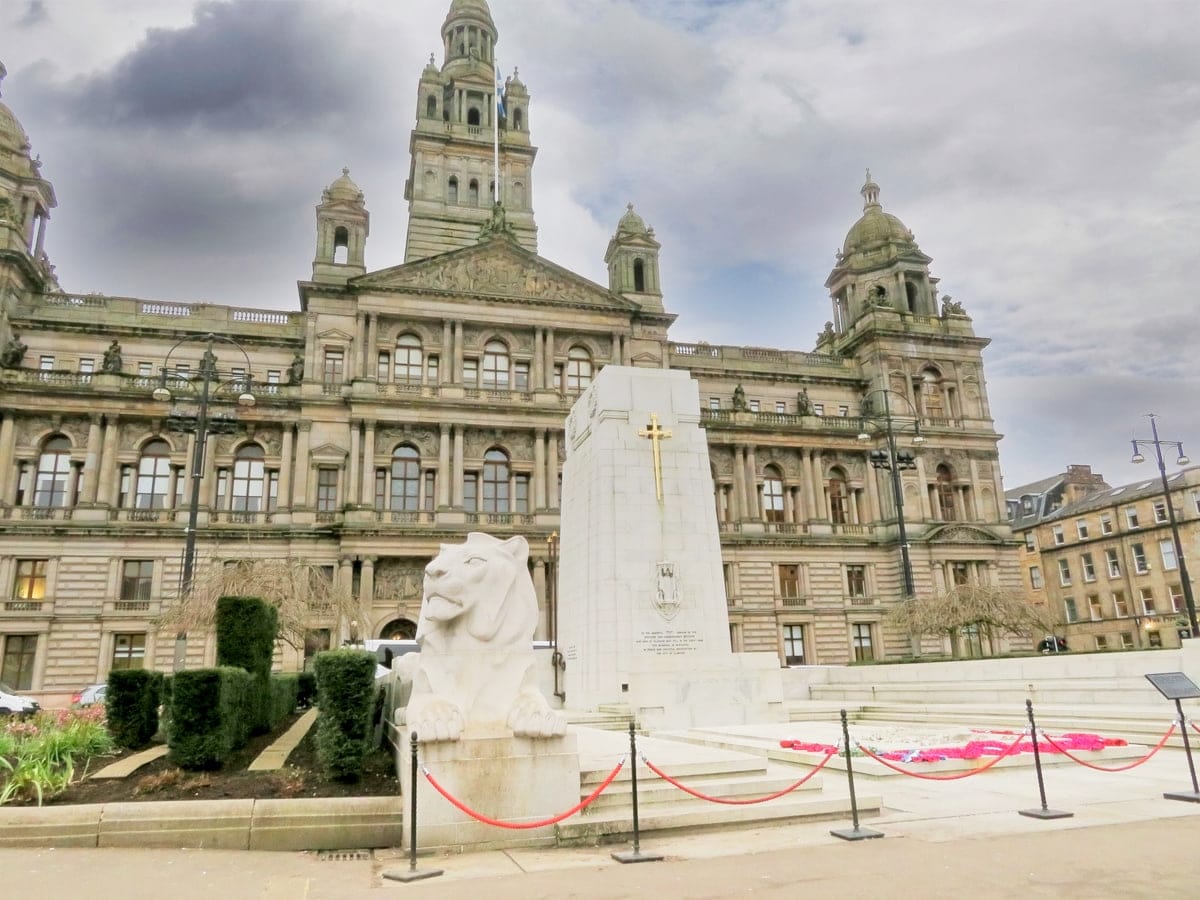
Things to Do
Historical Tour: Immerse yourself in the rich history of Glasgow by exploring George Square. Named after King George III, this square is home to numerous statues and monuments commemorating notable figures from Scotland’s past. Either see the square on a self-guided tour or join a guided tour courtesy of Get Your Guide.
City Chambers: Visit the Glasgow City Chambers on the eastern side of the square. With its stunning Victorian architecture and marble interiors, it’s a must-see. Free guided tours are available that allow you to explore the building and see the inner workings of the city council.
Street Performances: George Square is known for its vibrant atmosphere and frequent street performances. These range from musicians to magicians and dancers. The square also hosts events throughout the year including a Christmas festival and art exhibitions.
People’s Palace & Winter Gardens: This museum and glasshouse is located a short walk from George Square. During a visit, you’ll learn about the social history of Glasgow, its people, and their lives. The nearby Winter Gardens, meanwhile, houses exotic plants which makes it a great location to unwind after a day in the city centre.
Culinary Adventure: Around George Square, there’s a variety of restaurants and cafes offering a great choice of Scottish and international cuisine. From traditional haggis to modern fusion dishes, you can indulge in a culinary adventure to taste the many flavours of Glasgow.
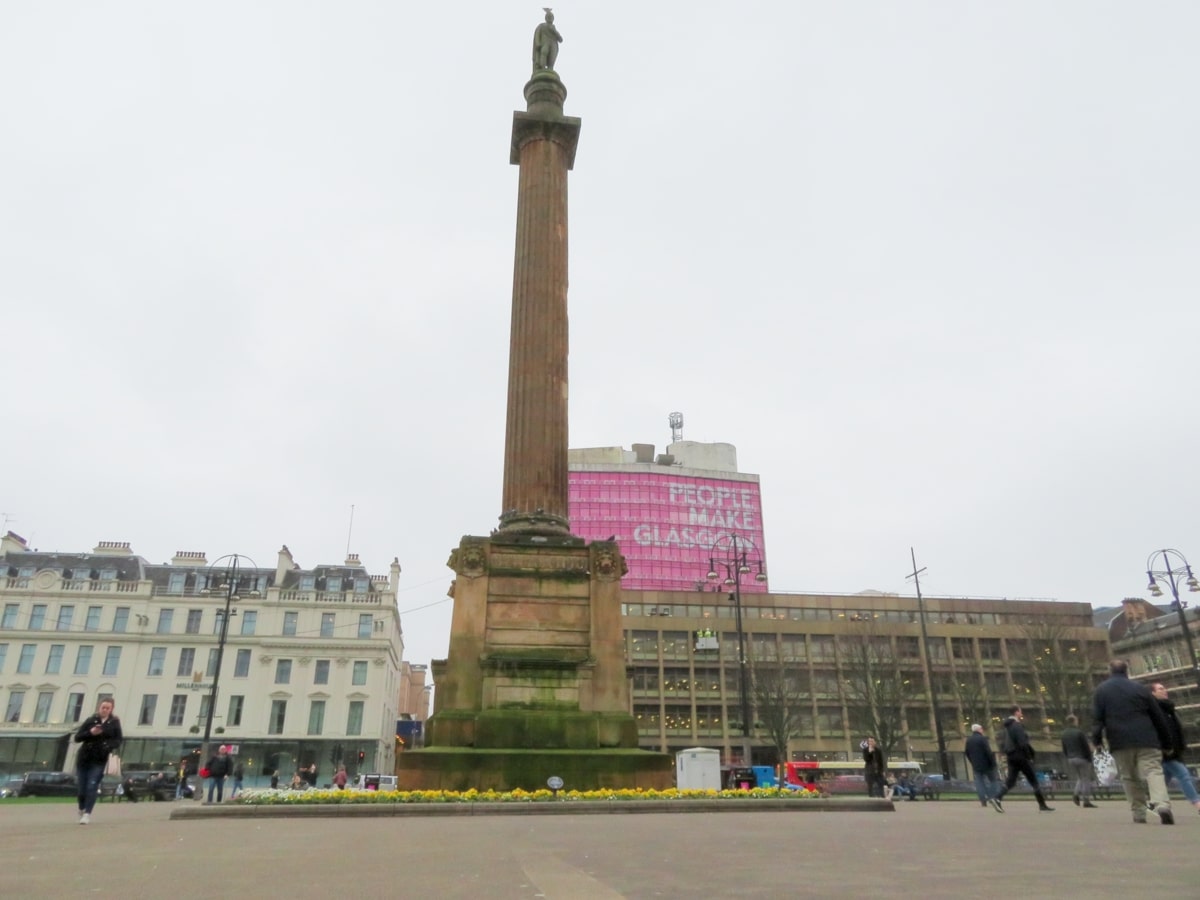
Things to Do Nearby
Glasgow Cathedral. Castle St, Glasgow G4 0QZ. 14-minute walk.
Founded in 1197, this is one of the largest Christian buildings in Scotland. Glasgow Cathedral is notable for its underground crypt and post-war stained-glass windows. Entry is free but donations are welcome.
The Necropolis. Castle St, Glasgow G4 0UZ. 16-minute walk.
The Necropolis is a large Victorian cemetery located behind Glasgow Cathedral. There are many footpaths winding their way around the 37-acre site and entry is completely free.
The Glasgow Gallery of Modern Art. 111 Queen St., Royal Exchange Square, Glasgow, G1 3AH. 2-minute walk.
The GOMA now resides in this elaborate structure, which was once a sizable city mansion belonging to a tobacco merchant. Visitors can view a collection of modern artworks in the permanent collection for free, and there are paid temporary exhibitions throughout the year. The GOMA also has a café and gift shop.
St. Mungo Museum of Religious Life. 12-minute walk.
This is a free-to-visit museum next to Glasgow Cathedral that displays religious artefacts and artworks from around the world. The museum has a café and gift shop on site.
The Lighthouse, 11 Mitchell Lane, Glasgow, G1 3NU. 6-minute walk.
A 7-story museum dedicated to art and design. Charles Rennie Mackintosh, a Glasgow architect, is the source of inspiration for the exhibition space. In addition to the exhibitions, there are guided tours of the building, a shop, and a café.
Frequently Asked Questions
What street is George Square on?
George Square is located in the heart of Glasgow city centre. It is not specifically on a street, but several streets surround it. These include George Street to the north, Queen Street to the east, St Vincent Place to the south, and South Frederick Street to the west.
What is George Square famous for?
George Square in Glasgow is known as the main civic square in the city. It is the location of Glasgow City Council and showcases several statues and monuments to famous Scots such as Robert Burns and Sir Walter Scott.
How did George Square in Glasgow get its name?
George Square opened in 1787 and was named after King George III.
What visitor facilities are there at George Square?
There are no visitor facilities in George Square but there are pubs, shops, and restaurants surrounding it. Glasgow Queen Street Station has public toilets.

